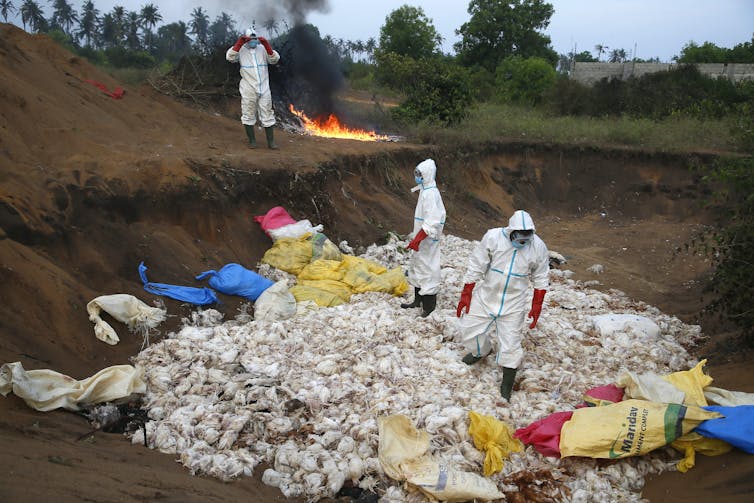Once again, Europe is experiencing bird flu outbreaks – the deadliest animal disease known. In chickens and turkeys, over 90% of an affected flock will die within a couple of weeks, although in ducks and geese the disease may be milder.
Bird flu outbreaks are caused by avian influenza viruses, most of which cause mild infection in birds, but two sub-types (called H5 and H7) can occur as a very deadly virus.
Flu viruses have a high mutation rate and can exchange genes when two viruses simultaneously infect a single host. These genetic changes allow them to change their make up and escape immunity in their host and continue spreading.
In the previous century, epidemics of the deadly bird flu were rare and always originated from mild H5 or H7 viruses that mutated into a deadly virus while transmitting in a chicken or turkey flock. Until 1996, resulting outbreaks and epidemics were either effectively controlled or faded out due to a lack of susceptible hosts.
H5N1 emerges
Infections caused by these deadly viruses were also never seen in wild birds. This changed after the emergence of the H5N1 virus in China. Outbreaks in poultry were not effectively controlled. The virus gradually expanded its territory across China, and from 2003, further into Asia and Africa. Humans in close contact with infected poultry could become infected, resulting in the death of 456 people to date.
Wild birds became infected because of a spillover from the ongoing spread of the virus in poultry. This gave rise to new H5 viruses that were still deadly to poultry, but of little harm to certain waterbird species. Consequently, migratory waterbirds could fly thousands of kilometres, despite being infected by these viruses, and so were able to spread the viruses over very large distances.
In 2005, wild waterbirds introduced the virus to Europe for the first time during fall migration. This was the first sign that the ecology of these viruses had completely changed; a virus strictly associated with poultry had adapted itself to wild water birds, tremendously increasing its survival potential.
Each year in spring and summer, waterbirds mingle on their breeding grounds in Siberia and mix their influenza viruses, creating new variants they then bring to Europe, Asia and Africa during fall migration, causing deadly outbreaks in poultry.
Obviously, there is little we can do to control infections in the wild water birds. Surveillance is recommended to assess the risk of virus exposure to poultry and the removal of carcasses of dead birds from the environment.

Poultry farmers in areas with many waterbirds that stay there over winter are advised to keep poultry inside and should implement biosecurity measures to keep the virus out of their sheds. Faeces of infected wild birds can contain high amounts of virus and can easily enter a poultry shed by uncleaned boots or materials.
Current biosecurity programmes have not been sufficiently effective to prevent infections in risk areas. In the season 2020-21 there were over 1,000 outbreaks in the EU alone. And in the current season, tens of outbreaks have already been detected.
The yearly recurring outbreaks, with the associated mass killing of poultry, are an obvious threat to the sustainability of poultry farming.
Poultry vaccine
Vaccination could be a tool to help solve the problem. However, it is forbidden in many countries and its use results in trade barriers for poultry. The reason for the trade barriers is that most current vaccines prevent disease, but don’t stop transmission of the infection.
A vaccine that stops disease but doesn’t stop transmission will result in “silent” virus spread, which compromises outbreak control and is undesirable because the virus has the potential to spread from animals to humans.
Fortunately, most of the currently circulating H5 virus variants are not as dangerous to humans as their ancestor H5N1. Still, caution is needed as this could easily change because of the virus’s ability to change its genetic code.
We urgently need effective vaccines for poultry – it is the only sustainable solution. New-generation vaccines may have more potential to control bird flu, but their effectiveness to stop virus transmission should be demonstrated in the field. Such vaccines will not only protect poultry but also minimise exposure of humans to the virus.
"bird" - Google News
November 22, 2021 at 11:27PM
https://ift.tt/3FAekHN
Bird flu outbreaks in Europe: what you need to know - The Conversation UK
"bird" - Google News
https://ift.tt/2s1zYEq
https://ift.tt/3dbExxU
Bagikan Berita Ini















0 Response to "Bird flu outbreaks in Europe: what you need to know - The Conversation UK"
Post a Comment